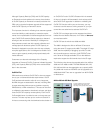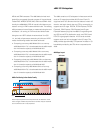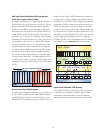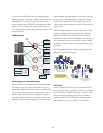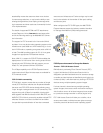13
The IBM z890 is the latest member of the zSeries family.
The design of the z890 is a continuation of the major
change in the direction of the zSeries platform started with
the IBM ^ zSeries 990. The implementation of the
superscalar microprocessor provides for improvements
in the performance of new workloads as well as maintain-
ing excellent performance for traditional workloads. The
z890 provides a lower capacity entry point as compared to
the z800, an increase in total system capacity almost 2.1
times that of the z800 Model 004, doubling the number of
CHPIDs, doubling the number of LPARs, quadrupling the
number of HiperSockets, and increasing the number of
ESCON channels by 75%, the number of FICON
®
channels
by 25%, the number of ISC-3s by 100% and the number of
OSA-Express Network connections by 67%. This server is
designed to provide you with the ability to improve applica-
tion performance, increase the number of users supported,
support more transactions, increase scalability, and con-
solidate workloads beyond what is available on a z800.
The performance design of the z/Architecture enables
the entire server to support a new standard of perfor-
mance for all applications through expanding upon a bal-
anced system approach. As CMOS technology has been
enhanced to support not only additional processing power,
but also more engines, the entire server is modifi ed to sup-
port the increase in processing power. The I/O subsystem
supports a great amount of bandwidth through internal
changes, thus providing for larger and quicker data move-
ment into and out of the server. Support of larger amounts
of data within the server required improved management
of storage confi gurations made available through integra-
tion of the software operating system and hardware sup-
port of 64-bit addressing. The combined balanced system
effect allows for increases in performance across a broad
spectrum of work. However, due to the wide range of
z890 Performance Comparisons
performance levels, z890 offers from 1-4 Central Proces-
sors each with 7 different “dial points” (28 choices in all)
and r
esource management within the system, it is expected
that there will be a large performance variability than has
been previously seen by our traditional customer set. The
z890 supports an estimated performance range of 0.14 to
7.40 compared to a z800 Model 001. This variability may be
observed in several ways. The range of performance rat-
ings across the individual LSPR workloads is likely to have a
larger spread than past processors. There will also be more
performance variation of individual LPAR partitions as the
impact of fl uctuating resource requirements of other parti-
tions can be more pronounced with the increased number
of partitions available on the z890. The customer impact of
this increased variability will be seen as increased devia-
tions of workloads from single-number-metric based factors
such as MIPS, MSUs and CPU time chargeback algorithms.
It is important to realize the z890 has been optimized to run
many workloads at high utilization rates.
It is also important to notice that the LSPR workloads for
z890 and z990 have been updated to refl ect more closely
our customers’ current and growth workloads. The tradi-
tional TSO LSPR workload is replaced by a new, heavy
Java technology-based online workload referred to as
Trade2-EJB (a stock trading application). The traditional
CICS
®
/DB2
®
LSPR online workload has been updated to
have a Web-frontend which then connects to CICS. This
updated workload is referred to as WEB/CICS/DB2 and
is representative of customers who Web-enable access
to their legacy applications. Continuing in the LSPR for
z890/ z990 will be the legacy online workload, IMS, and
two legacy batch workloads CB84 and CBW2. The z890/
z990 LSPR will provide performance ratios for individual
workloads as well as a “default mixed workload” which is
used to establish single-number-metrics such as MIPS,










